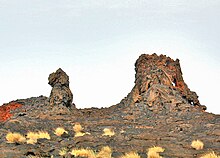Hornito


Hornitos (from the Spanish : small oven ) are chimney-like or chimney-like failure cone, which arise when a lava ascending lava is forced through the already solidified crust upward.
Hornitos are usually only a few meters high, but can also be up to 20 m high and often have quite steep sides so that they resemble turrets. A hornito is called a "rootless" cinder cone because it is only fed by the lava flow below, not by a deep chimney. Often a number of hornitos sit on a lava flow in the direction of flow or extend over a lava tunnel. They arise when residual amounts of volcanic gases escape explosively from the lava flow. Hornitos are often only short-lived structures and soon collapse again after the lava flow has stopped or its direction of flow has changed.
Examples of hornitos can be found in the crater of Ol Doinyo Lengai in Tanzania , on Puʻu ʻŌʻō in Hawaii , on Etna in Sicily and on Erta Ale in Ethiopia . Hornitos are also found numerous in Aðaldalur in the north of Iceland , they are around 2500 years old.
See also
Web links
- Hornito. Entry in the spectrum lexicon of geosciences.
- Hornito on Etna
Individual evidence
- ^ Rolf Schick: Earthquakes and volcanoes (= Beck series ). CH Beck, 1997, ISBN 3-406-41862-7 , pp. 100 .
